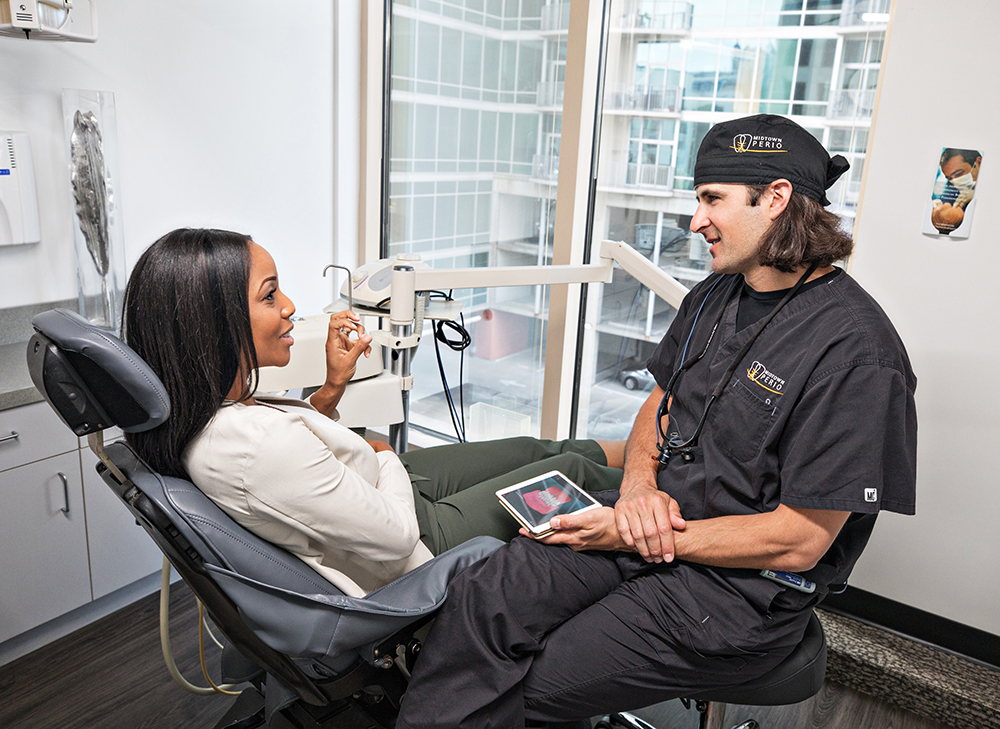Periodontal Abscess
Periodontal abscess is a localized accumulation of pus located within the gingival wall of the periodontal pocket/sulcus, resulting in a significant tissue breakdown. The primary detectable signs/symptoms associated with a periodontal abscess may involve ovoid elevation in the gingiva along the lateral part of the root and bleeding on probing. Other signs/symptoms that may also be observed include pain, suppuration (pus) on probing, deep periodontal pocket, and increased tooth mobility.
A periodontal abscess may develop in a pre-existing periodontal pocket, e.g., in patients with untreated periodontitis, under supportive therapy or after scaling and root planing or systemic antimicrobial therapy. A periodontal abscess occur- ring at a previously periodontally healthy site is commonly associated with a history of impaction or harmful habits.
How is periodontal disease Diagnosed?
Periodontists typically rely on a visual assessment of the patient’s overall oral condition in addition to charting pocket depths with a periodontal probe. This visual/mechanical method of assessing periodontal disease status can only tell whether or not disease is present. Radiographs (x-rays) are also incorporated into the evaluation to determine the extent, severity and pattern of bone loss to accurately diagnose your disease and recommend the proper method of treatment. While these are the most reliable assessment tools, your periodontist will also evaluate overall systemic health to determine if you possess a unique genetic susceptibility or risk factor to periodontal disease.
Overall
It’s no longer enough to simply exercise, eat well and avoid excess in order to maintain good health and a high quality of life. It’s clear that maintenance of oral, and particularly “periodontal” health, is critical to maintaining good overall health. An investment in your oral health is one that pays back over a lifetime. It pays you back at multiple levels and for years to come.
We passionately believe in the lifetime value of periodontal health and the synthesis between your periodontal and general systemic health. We pledge to always have an honest, upfront approach to discussing your treatment costs and provide optional treatments when it is appropriate.
Smoking or Tobacco Use
Smoking weakens your body’s immune system (ability to fight infection). Tobacco use is the most modifiable risk factor and has enormous influence on the development, progression and treatment results of periodontal disease. Smokers show a 2- to 8-fold increase risk for attachment and/or bone loss depending on the amount smoked, and the assessment parameters for disease severity. Smoking demonstrates a synergistic effect in terms of increased risk of periodontal disease severity when combined with other systemic factors, and also demonstrates a dose-dependent relationship with periodontal severity, possibly leading to tooth loss.
One of the proposed mechanisms of smoking on periodontal disease progression is the shift in microbial flora that results in more pathogenic bacteria. Smokers harbor greater percentages of these pathogenic bacteria which may lead to lower numbers of “protective” species when compared to non-smokers.
Periodontal treatment tends to be less likely to be successful in smokers than in non-smokers. Studies evaluating the efficacy of periodontal disease control and specific periodontal procedures including regenerative procedures, soft tissue grafting procedures and implant procedures have consistently demonstrated a negative effect from smoking on success rates.
Treatment in patients with periodontal disease must be focused on understanding the relationship between genetic and environmental factors. Only through the use of individual approach can we identify your risks and achieve better results.
- What does this mean for me if I am a smoker?
- You have 2x the risk for gum disease compared with a nonsmoker
- The more cigarettes you smoke = the greater your risk for gum disease
- The longer you smoke or have smoked = the greater your risk for gum disease



